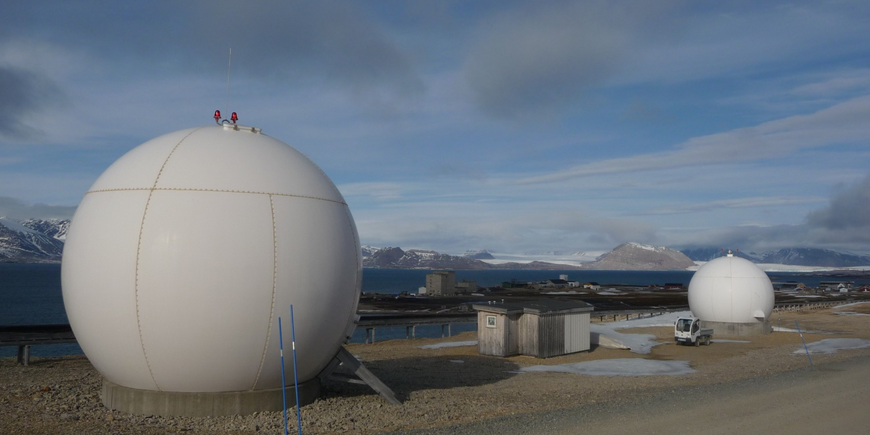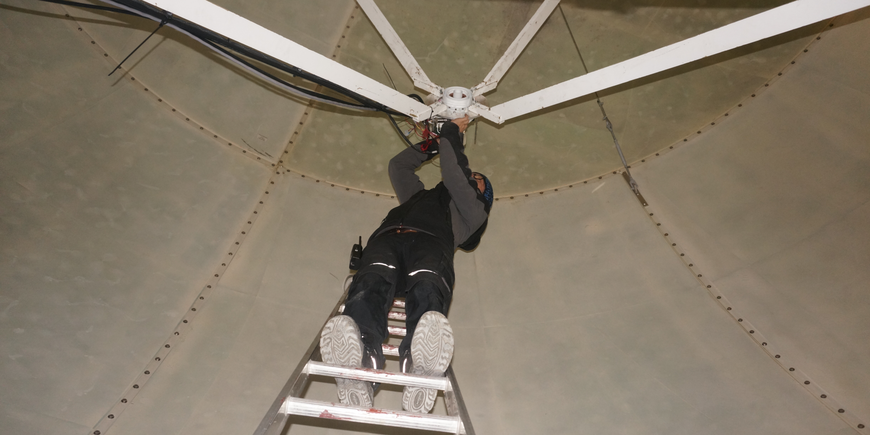The satellite receiving station operated by the GFZ in Ny-Ålesund on Spitsbergen (abbreviation NYA) has been receiving data from scientific satellites in polar orbits - automatically and remotely controlled from Potsdam - for over 20 years. Data is currently coming in particular from the two GRACE-FO satellites, which are being operated in cooperation with NASA. For this satellite mission, NYA is even used as the primary receiving station, which is also planned for the follow-up mission, which is scheduled to launch in 2028.
As part of the modular infrastructure MESI of the GFZ (Modular Earth Science Infrastructure), however, other satellites are also received with different cooperation partners. So far, the station has only used frequencies in the S-band (approx. 2.2-2.45 GHz), which will continue to be used in many satellite missions for transmitting the data measured on board the satellites back to Earth. Data rates of e.g. 3 megabits per second are common, as with the two GRACE-FO satellites. However, the bandwidths available in the S-band, and thus the possible maximum data rates, are limited (by global regulation of frequency bandwidths) and may not be sufficient, especially for satellite projects with higher data volumes.
In order to be able to support such satellite projects, one of the two antennas at the GFZ receiving station was upgraded to receive satellites in the X-band (approx. 7.9 - 8.4 GHz). In the X-band, significantly higher bandwidths are available for data transmissions and X-band reception in Ny-Ålesund can now even take place simultaneously with reception of the same satellites in the S-band, which is supported by many satellites (e.g. TerraSAR-X and TanDEM-X of DLR). Furthermore, in addition to the mostly used RHC polarisation (right hand circular), the LHC polarisation (left hand circular) can also be selected, and this independently of each other in both bands. The design and construction of the converter necessary for reception (converts the X-band frequencies to lower frequencies) was carried out by the GFZ, as was the integration and control of all other necessary systems in Ny-Ålesund (preamplifier, receiver, software, etc.).
At the receiving station, the microsatellite TUBIN (mass only 22.5 kg) could be received in the X-band for the first time at the end of November 2022, and since then almost daily, within the framework of a cooperation agreement with the TU-Berlin. TUBIN was developed and built by research assistants and students at the TU Berlin. It carries two cameras for the infra-red range, for detecting larger heat sources, such as forest fires in particular, as well as a camera for images in the visible range. The data rate for transmitting the images taken by TUBIN to the receiving station is 25 megabits/second, which is about eight times higher than that of GRACE-FO. Even higher data rates would be possible for the receiving station. The converter built at the GFZ has a very broadband design and the receiver used can receive up to 500 megabits/second.
The regular X-band reception of TUBIN at the GFZ receiving station benefits not only the TUBIN project, but also the GFZ, because in this way valuable experience can be gained for the technically more demanding reception operation at higher frequencies. In a next step, the station's second antenna is also to be expanded for reception in the X-band. This could then support not only satellite projects with higher data rates in the university sector, but also larger projects for which redundancies are indispensable.
Overview article on satellite reception in Ny-Alesund:
- Falck, C., Reißland, S., Snopek, K., Massmann, F.-H. (2020): Satellite data reception at Ny-Ålesund, Spitsbergen: From CHAMP to GRACE Follow-On. - ZfV: Zeitschrift für Geodäsie, Geoinformation und Landmanagement, 145, 2, 111-117. https://geodaesie.info/zfv/heftbeitrag/8568/zfv_2020_2_Falck_et-al.pdf





![[Translate to English:] [Translate to English:] Nahaufnahme des Satelliten in der Werkstatt](/fileadmin/_processed_/e/b/csm_Tubin_Satellit_Mario_Starke__TU_Berlin_4682e7d020.jpeg)







![[Translate to English:] Torsten Sachs in front of a climate station on a field](/fileadmin/_processed_/3/9/csm__TorstenSachs_bearbeitet_GS_4a1365ef84.jpeg)

![[Translate to English:] left image flood at the Ahrtal: image from above, several houses are flooded; left image:: Heidi Kreibich;](/fileadmin/_processed_/4/4/csm_Bild2_9af0130e9f.png)



![[Translate to English:] Start der Vega Rakete](/fileadmin/_processed_/6/4/csm_20231201-kachel_Vega-VV23-launch_ESA-CNES-Arianespace_706716b68c.jpeg)









![[Translate to English:] Poster exhibition at the Brandenburg Hydrogen Day at the GFZ, some participants in the foreground](/fileadmin/_processed_/6/5/csm_Erster_Brandenburgischer_Wasserstofftag_GFZ_402fcec95e.jpeg)
![[Translate to English:] Group picture of the participants](/fileadmin/_processed_/9/4/csm_20231108_CAWa-Workshop-Tashkent_Gruppenbild_99ea779d8a.jpeg)

![[Translate to English:] [Translate to English:] Hörsaal](/fileadmin/_processed_/e/6/csm_H%C3%B6rsal_e21ac645fb.jpeg)


![[Translate to English:] The Delegations in the Historic Library on the Telegrafenberg. In the back there are from left to right, the Dutch Ambassador for Germany, Ronald van Roeden, the Dutch Minister for Education, Culture and Science, Robbert Dijkgraaf and the scientific director of the GFZ, Susanne Buiter.](/fileadmin/_processed_/d/b/csm_Kachel-2_9eba4b4212.jpeg)

